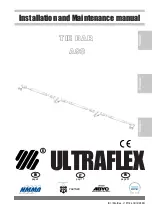
zebris Medical GmbH
FDM Technical Data and Operating Instructions
Page 53/54
Guidelines and Manufacturer's Statement - Electromagnetic Interference Immunity
The FDM-T force-distribution measuring system is intended for use in the electromagnetic environment described below. The customer
or user of the FDM-T force-distribution measuring system should ensure that it is operated in such an environment.
Interference immunity
tests
IEC 60601
test levels
Compliance
level
Electromagnetic environment guidelines
Portable and mobile wireless sets should not be used in closer proxim-
ity to the FDM-T force-distribution measuring system, including the ca-
bles, than the recommended safety distance, that is calculated on the
basis of the formula suitable for the transmitting frequency.
Recommended safety distance:
Conducted RF interference
quantities acc. to IEC
61000-4-6
3 V
eff
150 kHz
to 80 MHz
3 V
eff
P
d
2
.
1
Radiated RF interference
quantities acc. to IEC
61000-4-3
3 V/m
80 MHz
to 2.5 GHz
3 V/m
P
d
2
.
1
80 MHz to 800 MHz
P
d
3
.
2
800 MHz to 2.5 GHz
With
P
as the rated output of the transmitter in watts (W) according to
the information provided by the manufacturer of the transmitter und
d
as the recommended safety distance in meters (m).
The field strength from fixed RF transmitters as determined by an elec-
tromagnetic site survey
a
is less than the compliance level
b
in all the
frequencies.
Interference is possible in the proximity of devices featuring the follow-
ing pictograph
NOTE 1
The higher value applies in the case of 80 MHz and 800 MHz
NOTE 2
These guidelines may not be applicable in all situations. The spread of electromagnetic waves is influenced
by absorption and the reflections of buildings, objects, and people
a
The field strength of stationary transmitters, such as the base stations of mobile phones and land mobile services, ham radio
stations, AM and FM radio and TV broadcasters is theoretically not 100% predictable. A site study is recommended to determine
the electromagnetic environment as a result of stationary RF transmitters. If the measured field strength at the site of the FDM-T
force distribution measuring system exceeds the compliance levels listed above, the FDM-T force distribution measuring system
must be monitored to document its proper functionality at every place of application. Additional measures might become neces-
sary, e.g. modifying the orientation or moving the location of the FDM-T force-distribution measuring system, if unusual perfor-
mance characteristics are observed.
b
The field strength is less than 3 V/m for the frequency range of 150 kHz to 80 MHz
Recommended Safety Distances between Portable and Mobile RF Telecommunications Devices and
the FDM-T/FDM-T force-distribution measuring system
The FDM-T force-distribution measuring system is intended for use in an electromagnetic environment where RF interference quantities
are controlled. The customer or user of the FDM-T force-distribution measuring system can contribute towards preventing electromag-
netic emissions by complying with the minimum distance between portable and mobile RF telecommunications devices (transmitters)
and the FDM-T force-distribution measuring system, as recommended below in accordance with the maximum output power of the
communication device.
Rated output of the trans-
mitter (W)
Safety distance based on the transmitting frequency (m)
150 kHz to 80 MHz
P
d
2
.
1
80 MHz to 800 MHz
P
d
2
.
1
800 MHz to 2.5 GHz
P
d
3
.
2
0.01
0.12
0.12
0.23
0.1
0.38
0.38
0.73
1
1.2
1.2
2.3
10
3.8
3.8
7.3
100
12
12
23
The safety distance for transmitters with a rated output not listed in the table above, can be calculated by applying the formula corresponding to the
respective column, whereby P is the rated output of the transmitter in watts (W) as specified by the transmitter manufacturer.
NOTE 1
For calculating the recommended safety distance of transmitters in the frequency range of 80 MHz to 2.5 GHz,
an additional factor of 10/3 was used to reduce the probability of a mobile/portable telecommunications device
taken unintentionally into the patient's area, causing interference.
NOTE 2
These guidelines may not be applicable in all situations. The spread of electromagnetic waves is influenced by
absorption and the reflections of buildings, objects, and people.


































